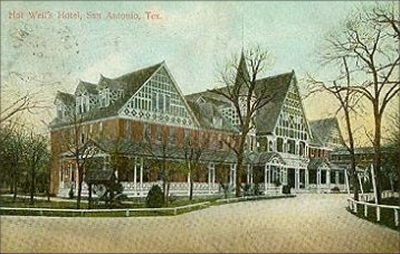Early Movie Making. (original) (raw)
Tourists coming to San Antonio for the first time may see the Alamo, the other old Spanish missions, Fort Sam Houston's quadrangle and the Buckhorn Saloon and think every venerable landmark in this historic city has been preserved for posterity.
But they would be wrong.
Off South Prensa Street on the edge of the city is a piece of private property where visitors are not welcome. If fact, a caretaker with dogs is on the premises not to answer questions in a friendly way, but to keep people off the place.
What the caretaker is guarding are the ruins of the old Hot Wells Hotel, a place that early in the 20th century was one of the Alamo City's prime resort spots.

San Antonio, Texas, Hot Wells
1907 Postcard courtesy www.rootsweb.com/ %7Etxpstcrd/
People seeking restored health or just an enjoyable soak in hot water came from across the country to the Hot Well bathhouse and hotel. Among the visitors were Teddy Roosevelt, Will Rogers, Rudolph Valentino, Tom Mix, Cecil B. De Mille and many others.
The hotel was built in 1886. It was an elegant four-story Victorian structure occupying 21 acres along the San Antonio River. The frame hotel was destroyed by fire (in fact, it burned three times), but the remnants of the old bath house, a round building, are still there.
During the hotel�s hey day, hot sulfur water from several springs was piped to various swimming pools and bath areas. While the resort�s long gone, the springs still flow intermittently.

Hot Wells Hotel, San Antonio, Texas
1908 Postcard courtesy www.rootsweb.com/ %7Etxpstcrd/

Hot Wells, San Antonio, Texas
Postcard courtesy www.rootsweb.com/ %7Etxpstcrd/
| Back in 1996 screenwriter Frank Thompson set the scene at Hot Wells at the beginning of his interesting book, �The Star Film Ranch: Texas' First Picture Show.� The Star Film Company was the first movie company to do any substantial business in Texas. Owned by French producer Gaston Melies, the company came to San Antonio in January 1910 from Brooklyn. | | | ---------------------------------------------------------------------------------------------------------------------------------------------------------------------------------------------------------------------------------------------------------------------------------------------------------------------------------------------------------------------------------------------------------- | |
The movie industry was in its infancy, but the American appetite for film already was hearty. Feature films ran only about 15 minutes -- or 1,000 feet of film -- and long runs in theaters were unheard of. As Thompson explains in his book, people did not go to see a particular film, they "went to the movies." They expected to see a mixed bag of entertainment, drama, comedy, news, travel, and come back soon for something new.
This demand necessitated year-round shooting, but since almost all shots had to be made outside during these early years, movie companies based in the Northeast had to find places with weather more suitable for winter filming. Most companies went to California, and a couple of companies filmed in Colorado and Utah. But Melies chose San Antonio, where he set up shop adjacent to the Hot Wells Hotel.

Hot Wells, San Antonio, Texas
Postcard courtesy www.rootsweb.com/ %7Etxpstcrd/
From early 1910 to April 11 that year, he did some 80 movies -- mostly Westerns -- in San Antonio, including a minor classic, "The Immortal Alamo." The film featured future director John Ford's older brother, Francis Ford, as Navarre, the villain. Being producer, Melies award himself the role of a padre. Students from Peacock Military Academy played Santa Anna's soldiers.
Unfortunately, because of the nitrate used in early film, only a few of these made-in-San Antonio films have survived. Aside from these scratchy one-reelers, all we have are a collection of movie still shots, movie summaries from trade publications, and a smattering of later-day recollections from earlier interviews of some of the people who were there.
The people connected to Texas' first brush with the film industry are all gone, too. Thompson found no survivors of the era, none connected with the film industry and none in San Antonio, during his research for his book.
Given the cultural and historical importance of old movies, as Thompson wrote, it is "a melancholy task, trying to recapture a lost era" when so little evidence of it has survived.
�
Mike Cox
"Texas Tales" April 11 , 2009 column
Related Topics:
Rooms with a Past
Texas Theatres
Texas Books
See San Antonio
Books by Mike Cox - Order Here